| Share |  |
 | |||
Nutrition Labels Made Simple: What's Most Important for Your Health?
Nothing affects our health more than what we put in our mouths each and every day. Ideally, the way to promote a healthy body is to only eat unprocessed and unaltered foods in their whole, natural form. But with our modern-day busy lifestyles, even people who are health-conscious purchase at least a certain amount of foods that come in a can, jar, bag, box or some form of packaging. For the average person, processed foods make up 70 percent of the foods they consume every day.
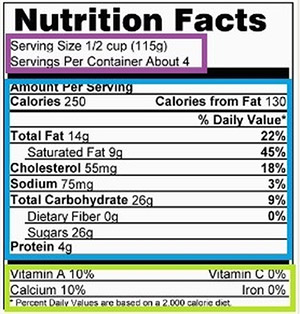 Fortunately, we do live in a country that requires food manufacturers to disclose the ingredients used in the products we purchase. Without such nutrition labels, we would be unaware of just what ingredients we were putting into our bodies and clueless about the amounts.
Fortunately, we do live in a country that requires food manufacturers to disclose the ingredients used in the products we purchase. Without such nutrition labels, we would be unaware of just what ingredients we were putting into our bodies and clueless about the amounts.
While nutrition labels are indeed valuable, the average person can easily feel overwhelmed by all the data and what it all really means to their health. Plus the amount of time it takes to really examine and analyze labels is simply more than most people can spare or are willing to invest.
Since the type and amount of certain ingredients can make or break your health, it is vital to at least know the basic facts about the contents of the product you are purchasing. Contrary to popular belief, ignorance is not bliss and what you don’t know can hurt you.
Hidden Health Hazard
Harmful chemical additives and altered fats (i.e., trans fats or any hydrogenated or partially hydrogenated fats) are indeed ingredients you want to closely watch out for and avoid when 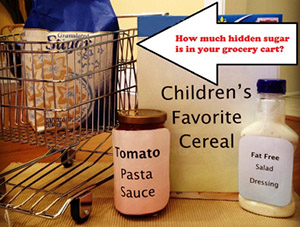 choosing processed foods. But if I had to narrow it down to just one health hazard, I would have to choose added sugar as the most detrimental in our processed food supply. And because so much is “hidden” in these foods and beverages, very few people realize just how much they are consuming.
choosing processed foods. But if I had to narrow it down to just one health hazard, I would have to choose added sugar as the most detrimental in our processed food supply. And because so much is “hidden” in these foods and beverages, very few people realize just how much they are consuming.
Most everyone knows that sugar is high in soft drinks (the worst!), energy drinks, candy, baked goods, ice cream and the like. But far less realize the degree to which it is added to breads, crackers, soups, pizza, chicken nuggets, salad dressings, mayonnaise and countless other foods not normally considered sweet. Consider this staggering fact:
Out of the approximately 600,000 processed foods found in grocery stores today, more than 80% contain added hidden sugar!
In her recent book, Sugar Saavy, Kathie Dolgin gives a number of examples of how much sugar is 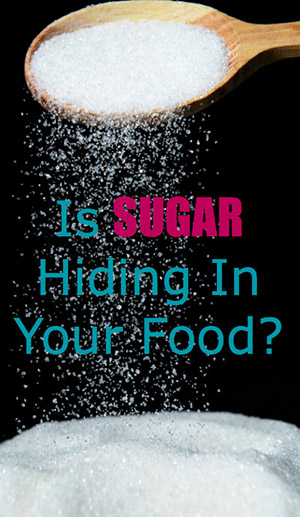 hidden in foods we would not suspect. For instance, just ¼ cup of Kraft French Dressing contains as much sugar as a full-size Reese’s Peanut Butter Cup. Eating two Oreo cookies gives you less sugar than ½ cup of Prego Traditional pasta sauce and six Dole pineapple rings in heavy syrup contain more sugar than a cup of Ben and Jerry’s Chunky Monkey Ice Cream. Even a small half cup size container of “healthy” Activia fruit yogurt has the sugar equivalent of two chocolate glazed donuts!
hidden in foods we would not suspect. For instance, just ¼ cup of Kraft French Dressing contains as much sugar as a full-size Reese’s Peanut Butter Cup. Eating two Oreo cookies gives you less sugar than ½ cup of Prego Traditional pasta sauce and six Dole pineapple rings in heavy syrup contain more sugar than a cup of Ben and Jerry’s Chunky Monkey Ice Cream. Even a small half cup size container of “healthy” Activia fruit yogurt has the sugar equivalent of two chocolate glazed donuts!
From 1977 to 2000, Americans doubled their dietary sugar intake and current figures from the USDA indicate that the average person consumes approximately 156 pounds of sugar, which represents 20-25 percent of total calorie consumption. Table sugar only represents about 29 pounds – all the rest is all hidden in foods and beverages. It is no wonder than two out of three people today in this country are overweight or obese.
Addictive Nature of Sugar
No other substance added to foods is as highly addictive as sugar. Not only is its chemical composition nearly identical to cocaine but studies also show that it is actually eight times more addictive. In fact, when given the choice of cocaine or sugar water, cocaine-addicted laboratory rats chose sugar in 40 out of 43 cases.
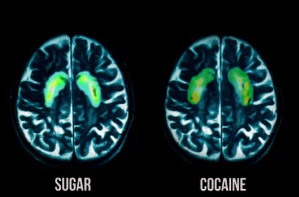 Sugar triggers the release of opiate-like endorphins that over-activate the pleasure centers of the brain. Our brain literally lights up in response to sugar just as it does for cocaine and heroin. Food manufacturers pay scientists well to discover the “bliss point” that most triggers our brain’s endorphins to ensure that we keep coming back for more.
Sugar triggers the release of opiate-like endorphins that over-activate the pleasure centers of the brain. Our brain literally lights up in response to sugar just as it does for cocaine and heroin. Food manufacturers pay scientists well to discover the “bliss point” that most triggers our brain’s endorphins to ensure that we keep coming back for more.
To make matters worse, the more sugar you eat, the more blunted the reward center in the brain becomes, which means you require even more sugar to feel good. In other words, the more sugar we eat, the more our bodies get acclimated to high levels and the more we want. Considering the degree to which the influence of sugar on our brain affects hormones that control hunger and satiety (ghrelin and leptin), it is little wonder that it is so hard to stop eating it.
Sugar’s Impact on our Health
Sugar is the primary driver of chronic inflammation that leads to heart disease, cancer, dementia, Alzheimer’s, and a host of associated conditions such as insulin resistance, high triglycerides, fatty liver, high blood pressure, metabolic syndrome, pre-diabetes and type 2 diabetes. 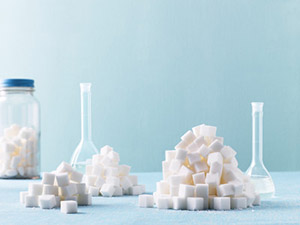 Blood sugar levels that stay too high for too long trigger the release of excess insulin that eventually leads to insulin resistance, the root cause of many of these conditions. In addition, glucose that remains high in the blood chemically reacts with proteins, forming AGEs or Advanced Glycated End-products that generate free radical activity and lead to pre-mature aging, organ dysfunction, plaque formation and damage to tissues, nerves and blood vessels throughout the body.
Blood sugar levels that stay too high for too long trigger the release of excess insulin that eventually leads to insulin resistance, the root cause of many of these conditions. In addition, glucose that remains high in the blood chemically reacts with proteins, forming AGEs or Advanced Glycated End-products that generate free radical activity and lead to pre-mature aging, organ dysfunction, plaque formation and damage to tissues, nerves and blood vessels throughout the body.
Due to the widespread use of sugar in our food supply, the incidence of type 2 diabetes is reaching epidemic proportions. Although the onset of type 2 diabetes historically occurs in middle to later life, it is now tragically a common diagnosis among unprecedented numbers of children and adolescents who today are also more overweight than ever before. A study released within the last year showed a 30 percent increase in type 2 diabetes in children since 2001. One in four teenagers are now either pre-diabetic or diagnosed with type 2 diabetes. One out of 10 children has a fatty liver and at least forty percent are seriously overweight.
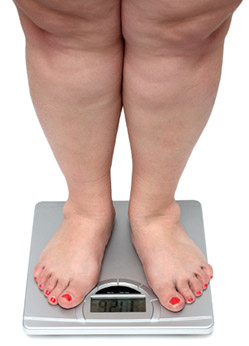 Sugar programs the body to store fat and is the primary reason people have difficulty losing weight. Body fat accumulates when the body gets used to burning carbohydrates for fuel instead of fats. Regular sugar consumption keeps people on a blood sugar roller coaster, causing hunger levels and cravings to skyrocket and energy to plunge. Elevated blood sugar makes cells less sensitive to insulin as well as leptin (the hormone that inhibits overeating). Plus the stress of extreme blood sugar fluctuations raises cortisol levels (a stress hormone), which increases belly fat and decreases fat burning.
Sugar programs the body to store fat and is the primary reason people have difficulty losing weight. Body fat accumulates when the body gets used to burning carbohydrates for fuel instead of fats. Regular sugar consumption keeps people on a blood sugar roller coaster, causing hunger levels and cravings to skyrocket and energy to plunge. Elevated blood sugar makes cells less sensitive to insulin as well as leptin (the hormone that inhibits overeating). Plus the stress of extreme blood sugar fluctuations raises cortisol levels (a stress hormone), which increases belly fat and decreases fat burning.
Sugar also feeds the bad bacteria in the gut, which alters the delicate balance of intestinal flora. This leads to the development of conditions such as gas, bloating, cramps, diarrhea, constipation and inflammatory symptoms like fatigue, body aches, headaches, and joint problems.
Added sugar not only racks up calories without providing nutrients but depletes the body of key nutrients required to metabolize it. Sugar that occurs naturally in foods, on the other hand, contains the fiber, water, vitamins, minerals and other phytonutrients that help our bodies instead of adversely affecting them.
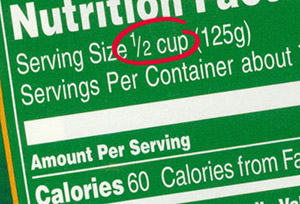 Interpreting Nutrition Labels for Added Sugars
Interpreting Nutrition Labels for Added Sugars
Before you can arrive at the number of teaspoons of sugar in a product, you first need to determine what constitutes a single serving. Be aware that a product serving size does not necessarily represent the amount an average person would consume at one sitting. To more accurately calculate sugar grams, multiply the total grams per serving by the number of servings you would actually consume. To determine the teaspoon amount, divide that answer by four. All you really need to know ahead of time is one simple fact:
4 grams of sugar = 1 teaspoon.
Keep in mind that the label with Nutrition Facts makes no distinction between added or naturally occurring sugar. On certain products, sugar grams do include sugars such as lactose in milk products or fructose from products containing fruit. Apart from those exceptions, however, you can generally assume that the number of sugar grams represents added sugars.
To more accurately assess the product’s sugar content, you will need to check the label ingredients to notice the sources of sugar. Check over the list after the conclusion of this article to become more familiar with other terms that translate to added sugar. As you may well know, ingredients are listed in descending order by the amount the product contains, starting with the one that is most plentiful. If any type of sugar is listed in the first few ingredients, know that the product contains entirely too much sugar and really should 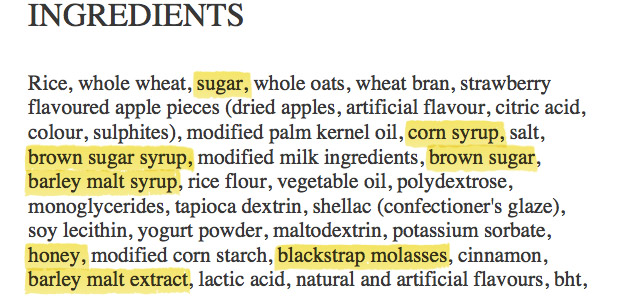 be left on the shelf if you want to protect your health and/or the health of your family.
be left on the shelf if you want to protect your health and/or the health of your family.
Even if no type of sugar is listed in the first few ingredients, the product could still contain entirely too much due to the sneaky practices of food manufacturers, who often use lesser amounts of a variety of different types of sugars to make it seem like the total sugar amount is not too high. Regardless of whether the source is “natural” like honey or one of the many less recognizable forms of sugar, it all adds up to a lot of sugar that can excessively raise your blood sugar and harm your health.
Lastly, do not depend on labels that may claim “no added sugar” or “sugar-free” as they can be very deceptive. The fact that a product says “no sugar added” does not mean the product lacks carbohydrate ingredients that will raise blood sugar. Products that say “sugar-free” may have less than 0.5 grams of sugars per serving, but they still contain calories and carbohydrates from other sources such as sugar alcohols.
Watch Out for These Sweeteners!
More than the amount of calories, you should focus your concern on the type of calories and the source of those calories. I would encourage you to read the following sections to understand the “whys” of avoiding the following types of sweeteners, especially if you are interested in protecting your health and/or are trying to lose weight.
High Fructose Corn Syrup
Overconsumption of fructose, particularly in the form of HFCS (High Fructose Corn Syrup), accounts for a significant portion of the damaging metabolic effects of sugar from processed foods and beverages. In the same time period that the use of HFCS in these products went from zero to over 60 pounds a person per year, obesity rates in this country tripled while the incidence of diabetes increased more than seven-fold.
HFCS is about 20 percent sweeter than table sugar and, due to government corn farm subsidies, far cheaper to make. Considering the extra profit it yields for food manufacturers, it is little wonder its use has skyrocketed since its discovery in the late 1970s.
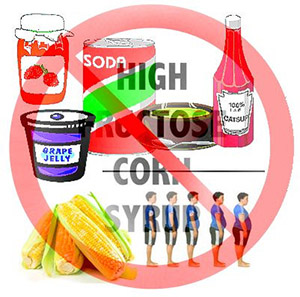 More calories are consumed from HFCS than any other source since it makes up more than half of all sweeteners used. Breads, buns, baking mixes, cereal and protein bars, muffins, crackers, cola and other sodas, barbeque sauce, ketchup, pasta sauce, salad dressings, fruit drinks, fruit juice blends, jams and jellies are the most common grocery store items that contain HFCS.
More calories are consumed from HFCS than any other source since it makes up more than half of all sweeteners used. Breads, buns, baking mixes, cereal and protein bars, muffins, crackers, cola and other sodas, barbeque sauce, ketchup, pasta sauce, salad dressings, fruit drinks, fruit juice blends, jams and jellies are the most common grocery store items that contain HFCS.
The great majority of regular sodas are sweetened with HFCS. A typical 20-ounce bottle contains 16-20 teaspoons of sugars from HFCS. High amounts of liquid calories especially lead to weight gain since they fail to contribute to fullness like solid foods and people rarely eat less to compensate for the added calories. Nor do they walk the extra hour it would take to burn off the calories just one bottle contains.
Why is HFCS considerably more detrimental to health than regular table sugar (sucrose)? Sucrose is comprised of two sugar molecules (glucose and fructose) tightly bound together in an equal ratio. The chemical enzymatic process that produces HFCS destroys that natural bond plus it converts some of the glucose to fructose. As a result, the final product consists of unbound fructose and glucose with a higher fructose (55 percent) to glucose (45 percent) ratio. Both molecules rapidly absorb, bypassing the digestive process normally required to sever them in their unaltered state.
The fructose molecule is what makes sugar taste so sweet. Because fructose is absorbed more rapidly, it goes straight to the liver and does not stimulate an insulin response. Any significant amounts are converted by the liver into free fatty acids, VLDL (the damaging form of cholesterol) and triglycerides. High triglycerides decrease the transport of leptin signals to the brain. As a result, a person’s appetite gets stuck in the “on” position since the body does not realize it is full and needs to quit eating. Leptin resistance makes a person feel unsatisfied and apt to overeat and is a primary root cause of obesity and problems losing weight.
Another problem with fructose is that it fails to suppress the hormone that makes you feel hunger (ghrelin), which means hunger pangs can remain high the rest of the day and even into the next day after you consume a food or beverage made with HFCS. In studies, rats with access to high-fructose corn syrup gained significantly more weight than those with access to table sugar, even when their overall caloric intake was the same.
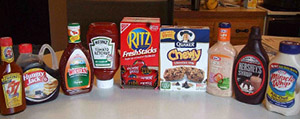 Besides the fact that dietary fructose leads to increased calorie intake and weight gain, the dramatic rate at which HFCS enters the blood stream wrecks havoc on blood sugar balance. This imbalance stresses the body and causes it to release cortisol (stress hormone) for hours in an attempt to correct the situation. High cortisol levels increase belly fat, kill brain cells, contribute to insulin resistance and can wear out the adrenal glands over time.
Besides the fact that dietary fructose leads to increased calorie intake and weight gain, the dramatic rate at which HFCS enters the blood stream wrecks havoc on blood sugar balance. This imbalance stresses the body and causes it to release cortisol (stress hormone) for hours in an attempt to correct the situation. High cortisol levels increase belly fat, kill brain cells, contribute to insulin resistance and can wear out the adrenal glands over time.
Free fructose also drains energy molecules needed to maintain the integrity of our intestinal lining. Too much can increase its permeability and contribute to leaky gut syndrome (a condition that allows byproducts of toxic gut bacteria and partially digested food proteins to enter the blood stream and trigger an immune reaction and inflammation).
The bottom line? Seeing HFCS on a product label is a good reason not to buy it since it is likely a poor-quality, nutritionally-depleted, processed food with empty calories and artificial ingredients that will diminish your level of health.
Artificial Sweeteners
Artificial sweeteners are worst for your health and cause greater weight gain than real sugar. Even though they are “calorie free,” they activate sweet taste receptors and generate responses in the body that set up the expectation of calories. As a result, the body misses the clues it would normally look for to know when to stop eating because it no longer can correlate the degree of a food’s sweetness to the amount of calories it contains. Since the brain responds to sweetness with signals to eat more, providing a sweet taste without any calories only triggers cravings and sets you up to overeat and crave more sweets.
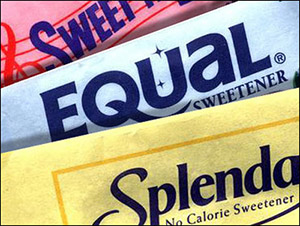 Beyond that effect, artificial sweeteners trigger an insulin response just as if you ate sugar and stimulate the release of a substance (incretin) that contributes to increased absorption of glucose. Raising insulin tells the body to store fat and leads to leptin and insulin resistance over time. According to research presented at the 2009 annual meeting of the Endocrinology Society, people who use artificial sweeteners are more likely to be heavy, insulin-resistant and diabetic than non-users.
Beyond that effect, artificial sweeteners trigger an insulin response just as if you ate sugar and stimulate the release of a substance (incretin) that contributes to increased absorption of glucose. Raising insulin tells the body to store fat and leads to leptin and insulin resistance over time. According to research presented at the 2009 annual meeting of the Endocrinology Society, people who use artificial sweeteners are more likely to be heavy, insulin-resistant and diabetic than non-users.
Studies also reveal that diet soda drinkers consume twice as much soda as the sugar-soda drinkers. One study that conducted MRI scans of the brain showed that sugar activated brain regions involved in food reward whereas Splenda (sucralose) used in the research did not. The conclusion of the study was that using sucralose did not fully satisfy the desire for ingesting something sweet and instead contributed to cravings. As JJ Virgin says in her newest book, The Sugar Impact Diet, “when you eat sweet, you crave sweet.”
Another problem with artificial sweeteners is that the degree of sweetness they deliver goes far beyond what you would ever find in nature. For instance, the product “Equal” (aspartame) is 200-300 times sweeter than table sugar, “Splenda” (sucralose) is 600 times sweeter and “Sweet’N Low (saccharin) is up to 700 times sweeter.
In addition, the body treats non-nutritive chemical substances as toxins as they cannot be metabolized by the body. After they are processed by the liver, they are stored away in fat cells to keep them out of the bloodstream in an effort to protect the rest of the body. It is ironic that people use artificial sweeteners in an effort to lose weight since what they are actually doing is filling their fat cells with toxins and encouraging the body to hold onto fat stores in the process.
Cautions Regarding Other Forms of Sugar
While the following sweeteners are not as bad as HFCS or artificial sweeteners, each do have some drawbacks or health implications that you should be aware of when checking out product nutrition labels for hidden sugars.
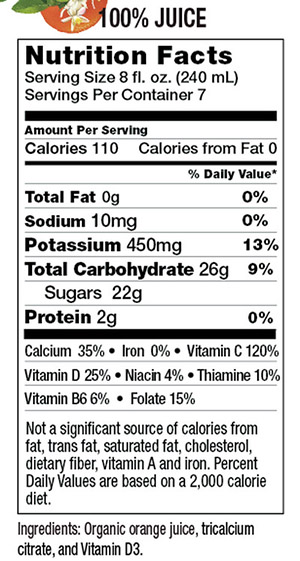 Fruit Juice, Fruit Concentrates, and Purees – don’t be fooled into thinking these “naturally” sweet options are fine for your health. Many juices are worst than sugary soft drinks. Even when juice is the 100 percent type, it is high in fructose plus it consists of what amounts to several pieces of fruit consumed at one time with no fiber to slow down its entry rate into the bloodstream. For example, just eight ounces of apple juice contains 28 grams or 7 teaspoons of sugar and eight ounces of cranberry juice has 36 grams or 9 teaspoons. Juices made with added HFCS or concentrated fruit juices are even worse. When the fiber and water is removed, only the sugar remains and that mostly in the form of fructose. Do not be misled by products that use fruit concentrates or purees as sweeteners and then advertise “no sugar added.” The processing the fruit goes through strips it of the antioxidants and other nutrients and reduces it to a sugary syrup.
Fruit Juice, Fruit Concentrates, and Purees – don’t be fooled into thinking these “naturally” sweet options are fine for your health. Many juices are worst than sugary soft drinks. Even when juice is the 100 percent type, it is high in fructose plus it consists of what amounts to several pieces of fruit consumed at one time with no fiber to slow down its entry rate into the bloodstream. For example, just eight ounces of apple juice contains 28 grams or 7 teaspoons of sugar and eight ounces of cranberry juice has 36 grams or 9 teaspoons. Juices made with added HFCS or concentrated fruit juices are even worse. When the fiber and water is removed, only the sugar remains and that mostly in the form of fructose. Do not be misled by products that use fruit concentrates or purees as sweeteners and then advertise “no sugar added.” The processing the fruit goes through strips it of the antioxidants and other nutrients and reduces it to a sugary syrup.
Agave nectar –although agave is regarded as a “natural sweetener” and is widely used in products that claim to be good for health, most kinds are so highly processed and refined that they bear no resemblance to the substance derived from the plant of origin. Nutrients in the plant are destroyed in the processing. But the greater problem with agave is that the fructose content is higher than any commercial sweetener, ranging from 70 to 97 percent, depending on the brand. While it is low glycemic due to lower amounts of glucose, the high fructose content makes it as problematic as HFCS when it comes to health and weight management.
Honey – high quality honey that is raw and unprocessed contains natural antioxidants, enzymes, amino acids, vitamins, and minerals. Unfortunately, most grocery store honey used in the manufacturing of packaged foods is lower quality grade A honey. Because it is heavily processed using high heat, many of its healthful benefits are lost. Manuka honey is one that is less processed and still possesses many health benefits. However, keep in mind that all honey is high in fructose and should only be consumed in minimal amounts.
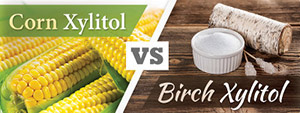 Sugar Alcohols – sweeteners such as xylitol, sorbitol, mannitol, erythritol and maltitol are preferable to artificial sweeteners in that they do contain some calories and do naturally occur in foods like fruits. However, they are less sweet and contain fewer calories than sugar. The primary problem is that some of the calories are incompletely absorbed by the body and can cause digestive distress such as abdominal gas and diarrhea. Certain sugar alcohols used in moderation are certainly a better choice than refined sugar, artificial sweeteners, HFCS or agave. Xylitol and erythritol are the best options for not spiking blood sugar and pure xylitol (from the birch tree – not GMO corn cobs) does not usually produce the gas or bloating associated with other sugar alcohols and has some health benefits.
Sugar Alcohols – sweeteners such as xylitol, sorbitol, mannitol, erythritol and maltitol are preferable to artificial sweeteners in that they do contain some calories and do naturally occur in foods like fruits. However, they are less sweet and contain fewer calories than sugar. The primary problem is that some of the calories are incompletely absorbed by the body and can cause digestive distress such as abdominal gas and diarrhea. Certain sugar alcohols used in moderation are certainly a better choice than refined sugar, artificial sweeteners, HFCS or agave. Xylitol and erythritol are the best options for not spiking blood sugar and pure xylitol (from the birch tree – not GMO corn cobs) does not usually produce the gas or bloating associated with other sugar alcohols and has some health benefits.
Is There Any Safe Amount?
Regardless of the source, it is always best to minimize your exposure to sweeteners. Recommendations put forth by the World Health Organization last year lowered amounts for added dietary sugar from 10 percent of daily calorie intake to five percent. That amount translates to about six teaspoons or 25 grams per day for an adult with a normal body mass index (BMI). The American Heart Association’s has similar recommendations of six teaspoons a day for women and up to 9 for men. Obviously, the current average of 26 teaspoons a day far exceeds those amounts.
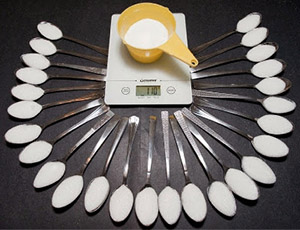 Irrespective of recommended guidelines, how much added sugar you allow yourself to consume really depends on the level of health you wish to enjoy. The reality is that added sugars are of no benefit to the body. The less you eat, the healthier you will be.
Irrespective of recommended guidelines, how much added sugar you allow yourself to consume really depends on the level of health you wish to enjoy. The reality is that added sugars are of no benefit to the body. The less you eat, the healthier you will be.
If you are overweight, have blood sugar imbalances or are addicted to sugar, even amounts deemed “safe” may be too much as any spikes in blood sugar can potentially advance those conditions. Those who crave sugar or are addicted to it (i.e., cannot just “take it or leave it”), may have to avoid it completely in order to break the addiction just the way a smoker needs to completely avoid cigarettes or an alcoholic needs to avoid all alcohol.
Take the Challenge!
The best way to know how much sugar is affecting your health or weight is to go completely off of all forms of it for a period of time and see how your symptoms or ability to lose weight is affected. By taking this challenge, you can also learn the extent to which you are truly addicted or not. You may be surprised, after you get through the hard part the first week, how much better you feel and how much easier it is to lose weight if you are carrying extra pounds.
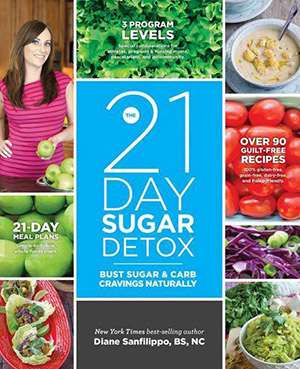 How long do you need to remove it completely from your diet? Generally a minimum of three weeks though you can experience weight loss and improved symptoms in as little as 10 days. Dr. Mark Hyman’s books UltraMetabolism and The Blood Sugar Solution recommend a six-week program to remove sugar and change your eating habits. To show people that they could experience impactful changes on their health and weight even in a shorter period of time, Dr. Hyman lays out an abbreviated program in his book The 10-Day Blood Sugar Detox Diet. The 21-Day Sugar Detox Diet by Diane Sanfilippo is another great program to help people get free from the sugar habit and improve their health at the same time. The Whole30 Program is a 30 day plan expounded on in the book It Starts with Food that removes sugar and other unhealthful foods from the diet to break addictions, rejuvenate overall health and energy and, yes, to lose weight if needed. JJ Virgin’s recently released Sugar Impact Diet plan is an excellent three week program that helps you identify the foods (including sugar) destructive to your health and gives you an easy-to-follow three-stage plan to transition to a healthier diet and lifestyle.
How long do you need to remove it completely from your diet? Generally a minimum of three weeks though you can experience weight loss and improved symptoms in as little as 10 days. Dr. Mark Hyman’s books UltraMetabolism and The Blood Sugar Solution recommend a six-week program to remove sugar and change your eating habits. To show people that they could experience impactful changes on their health and weight even in a shorter period of time, Dr. Hyman lays out an abbreviated program in his book The 10-Day Blood Sugar Detox Diet. The 21-Day Sugar Detox Diet by Diane Sanfilippo is another great program to help people get free from the sugar habit and improve their health at the same time. The Whole30 Program is a 30 day plan expounded on in the book It Starts with Food that removes sugar and other unhealthful foods from the diet to break addictions, rejuvenate overall health and energy and, yes, to lose weight if needed. JJ Virgin’s recently released Sugar Impact Diet plan is an excellent three week program that helps you identify the foods (including sugar) destructive to your health and gives you an easy-to-follow three-stage plan to transition to a healthier diet and lifestyle.
Concluding Thoughts
I hope this article will challenge you to examine more closely the sugar grams in food and beverage products before you buy them. Remember to figure out the amount of teaspoons in the serving size you might consume in one sitting and then imagine doling out that amount of teaspoons in a bowl and eating it at one time. Next, ask yourself, “is that sweet taste really worth the effect it may have on my health?” I think you will find that the resources I have recommended are great tools to help you get free of any sugar bondage and learn to enjoy the natural sweetness in whole foods just the way God made them.
Sources:
The Sugar Impact Diet by JJ Virgin, CNS, CHFS
Sugar Saavy by Kathie Dolgin
Sweet Deception by Dr. Joseph Mercola
Fat Chance by Dr. Robert Lustig
It Starts with Food by Dallas Hartwig, MS, PT, CISSN, RKC and Melissa Hartwig, CISSN, RKC
The 21-Day Sugar Detox Diet by Diane Sanfilippo, BS, NC
OTHER NAMES FOR SUGAR
The list below contains a reduced list for different names for sugar. Omitted from this list are a number of names that already include the word “sugar” in them such as “brown sugar” or grape sugar”.
|
|
Copyright © 2008-2015 Lucinda Bedogne, CNHP, CNC
Post Your Comment...
|
|
||||||||||||


